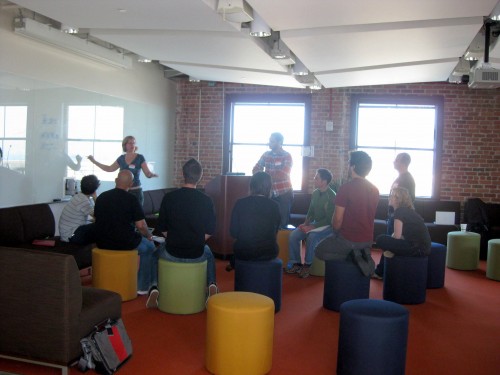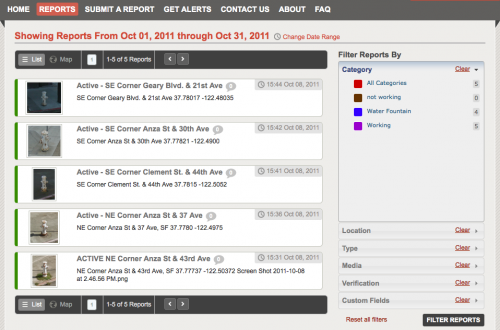Saturday, Fleet Week, Blue Angels, Silicon Valley Code Camp and a warm sunny day in San Francisco, and happily, about twenty people spent the day thinking about mapping their communities and verification of data. Though we planned for hacking code too, folks were drawn to these tasks.
 The question was how to think about (and possibly design in) more flexibility for verification in Ushahidi. Verification is a critical feature of journalism but what does verification mean within the context of crowdsourced and breaking news, such as when a report comes in through social media from a remote location? If a reporter in New York sees a tweet or Facebook mention of a bombing in Tahir Square, how can the reporter be confident in that report?
The group explored models for what variables might contribute to or detract from verification of the report. Big issues identified included the number of sources attached to one event, as well as popularity, location, time, reputation, history, and corroboration. One of the solutions, proposed by George Chamales, is an event-centric system: reports of events come in to the system, and each report is tied to a reporter. Reports could be aggregated into events by grouping reports with similar metadata or content (time, location, keywords, tags, etc.), potentially using a combination of natural language processing and human judgement. The reporter has data attached to it: the history (that this reporter has filed reports), the corroboration (that the event has also been reported on by other reporters, or does not run counter to other reports), and reputation (a problematic and arbitrary algorithm).
Corroboration rating could be measured on a scale:
The question was how to think about (and possibly design in) more flexibility for verification in Ushahidi. Verification is a critical feature of journalism but what does verification mean within the context of crowdsourced and breaking news, such as when a report comes in through social media from a remote location? If a reporter in New York sees a tweet or Facebook mention of a bombing in Tahir Square, how can the reporter be confident in that report?
The group explored models for what variables might contribute to or detract from verification of the report. Big issues identified included the number of sources attached to one event, as well as popularity, location, time, reputation, history, and corroboration. One of the solutions, proposed by George Chamales, is an event-centric system: reports of events come in to the system, and each report is tied to a reporter. Reports could be aggregated into events by grouping reports with similar metadata or content (time, location, keywords, tags, etc.), potentially using a combination of natural language processing and human judgement. The reporter has data attached to it: the history (that this reporter has filed reports), the corroboration (that the event has also been reported on by other reporters, or does not run counter to other reports), and reputation (a problematic and arbitrary algorithm).
Corroboration rating could be measured on a scale:
 Thanks to Alicia Johnson and Kristin Hogan of the City of San Francisco, Department of Emergency Management for answering our teams questions and providing us the idea to proto-map.
Thanks to Alicia Johnson and Kristin Hogan of the City of San Francisco, Department of Emergency Management for answering our teams questions and providing us the idea to proto-map.
Verification Brainstorming
 The question was how to think about (and possibly design in) more flexibility for verification in Ushahidi. Verification is a critical feature of journalism but what does verification mean within the context of crowdsourced and breaking news, such as when a report comes in through social media from a remote location? If a reporter in New York sees a tweet or Facebook mention of a bombing in Tahir Square, how can the reporter be confident in that report?
The group explored models for what variables might contribute to or detract from verification of the report. Big issues identified included the number of sources attached to one event, as well as popularity, location, time, reputation, history, and corroboration. One of the solutions, proposed by George Chamales, is an event-centric system: reports of events come in to the system, and each report is tied to a reporter. Reports could be aggregated into events by grouping reports with similar metadata or content (time, location, keywords, tags, etc.), potentially using a combination of natural language processing and human judgement. The reporter has data attached to it: the history (that this reporter has filed reports), the corroboration (that the event has also been reported on by other reporters, or does not run counter to other reports), and reputation (a problematic and arbitrary algorithm).
Corroboration rating could be measured on a scale:
The question was how to think about (and possibly design in) more flexibility for verification in Ushahidi. Verification is a critical feature of journalism but what does verification mean within the context of crowdsourced and breaking news, such as when a report comes in through social media from a remote location? If a reporter in New York sees a tweet or Facebook mention of a bombing in Tahir Square, how can the reporter be confident in that report?
The group explored models for what variables might contribute to or detract from verification of the report. Big issues identified included the number of sources attached to one event, as well as popularity, location, time, reputation, history, and corroboration. One of the solutions, proposed by George Chamales, is an event-centric system: reports of events come in to the system, and each report is tied to a reporter. Reports could be aggregated into events by grouping reports with similar metadata or content (time, location, keywords, tags, etc.), potentially using a combination of natural language processing and human judgement. The reporter has data attached to it: the history (that this reporter has filed reports), the corroboration (that the event has also been reported on by other reporters, or does not run counter to other reports), and reputation (a problematic and arbitrary algorithm).
Corroboration rating could be measured on a scale:
- 1 (perfect corroboration with other reports)
- 0 (not enough data)
- -1 (reports run counter to others) to ensure that outlier reporters are not penalized for unique reports.
"Verification discussions often abstract from communication to information. This is fine, but it means people often miss the most obvious verification method: simply contacting the reporters directly."
Prototype Mapping
The City of San Francisco, Department of Emergency Management - Water Hydrant map demo
With thousands of hydrants in the city, the map concept is to help understand the water resources available during emergencies. Residents of San Francisco can submit information about where hydrants are located, report their condition, and help us quickly identify when hydrants are not working. During emergencies this information can be used by the fire departments and public works to determine the status of the city's water resources and determine which hydrants require repair. Thanks to Alicia Johnson and Kristin Hogan of the City of San Francisco, Department of Emergency Management for answering our teams questions and providing us the idea to proto-map.
Thanks to Alicia Johnson and Kristin Hogan of the City of San Francisco, Department of Emergency Management for answering our teams questions and providing us the idea to proto-map.